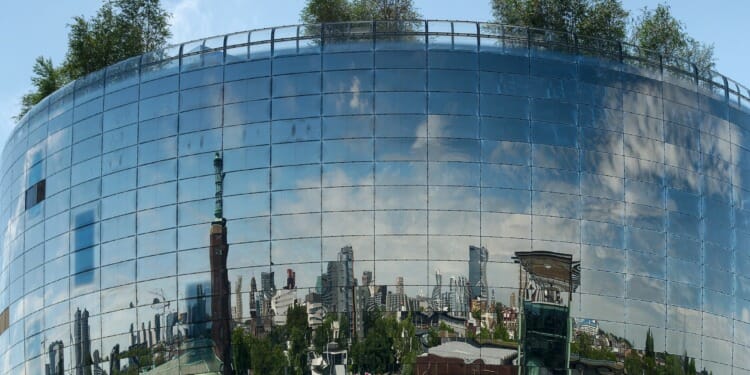On Saturday, after nearly 20 years of planning, the new purpose-built Depot opened in Rotterdam. Visitors now have access to the museum’s entire collection which includes works by Van Gogh, Magrittes and Dalís, some of which usually remain off view.
For many years, the Boijmans Van Beuningen Museum has only been able to display around 4% of its artwork in both temporary and permanent exhibitions – even in this reduced version, it remained a major attraction in the Netherlands, since it was the only Dutch museum that offered the whole range of Western art from the Middle Ages to the present.
However, now more than 63,000 paintings, photographs, films, sculptures and 88,000 drawings and prints are for the first time permanently available for viewing. The idea originally came about as a solution to major floods in Dutch museums. Items from the collection were having to be stored off-site at great expense.
The new building has been designed to protect the art from flooding, with a 10 metre overhang and being mainly raised off the ground. The flashy, mirrored exterior is made up of 1664 panels of 6,609 square metres of glass.
The museum has fundraised €55m, including a €27m donation from the De Verre Bergen Foundation to build a system where 151,000 works of art can be stored and viewed simultaneously. The building was designed by MVRDV, a local architectural firm. The works are hung in climate-controlled pull-out storage shelves which visitors can use to closely examine the art. Screening booths also allow people to view the digitised film library. On top of the works of art, all of the activities that go into looking after and managing a collection are on open view in the building.
“Museum of the future”, Rotterdam’s Boijmans Van Beuningen.
Depot, a bowl-shaped warehouse next to #Boijmans #museum’s original 1930s building in which all 151k items in its revered collection (Van Goghs, Magrittes, Dalís) on permanent display to public.https://t.co/WzTEWSpHHX— Bernedette Muthien (@BerneMuthien) November 3, 2021
‘Democratising’ the collection?
Sjarel Ex, the museum’s joint director, believes the storage facility’s lack of curation will “democratise” the collection, meaning no work will be positioned in a way that makes it any more important than the other works. He described visitors as going “through the collection like you would visit a library looking for a book and finding three others”.
With so much work on display, there is opportunity for exploration and for visitors to make their own discoveries with the museum experience becoming a personal adventure guided by instinct rather than curation.
Related Articles: Art Evolution: Challenges the Art Market Faces in the Digital Age | When Art is a Transformative Experience: Art Dubai
There is definitely something to be said for this. With such a clear “canon” of art history or the conventional timeline of artists who are considered as “Great Artists”, the Boijmans depot might allow for lesser-known works and artists in the collection to be considered on a more even playing field. It may even provide a starting point for further questioning of issues of gender, race, class and geography that have allowed certain works of art or artists to be more worthy of a position in the ‘canon’ than others.
 In the photo: Not to Be Reproduced ( La reproduction interdite ) is an oil on canvas painting by the Belgian surrealist artist René Magritte, Museum Boijmans Van Beuningen in Rotterdam. Photo credit: Jan Saudek
In the photo: Not to Be Reproduced ( La reproduction interdite ) is an oil on canvas painting by the Belgian surrealist artist René Magritte, Museum Boijmans Van Beuningen in Rotterdam. Photo credit: Jan Saudek
There is of course the risk that the lack of curation may leave visitors overwhelmed, with so much choice and no sense of the general chronology or set of ideas behind a series of works that one might expect from a trip to the museum.
However, an app is available for visitors to gain access to stories, trivia, photos, video and audio content which explores the background of the works in the collection. The app also includes “challenging viewing questions” which ask visitors to “actively look” and “discover more”.
This museum experience is unique in that it places a huge amount of importance on the viewer and their ideas.
What does this mean for the future of museums?
As a world first, it remains to be seen if this model will take off elsewhere, although the museum’s other director Ina Klaassen has commented that the museum has had conversations with “people from Korea, Norway, Singapore, they all came along, and yesterday there was a delegation from Qatar”.
Despite this, the new depot does not aim to replace the main museum, which is undergoing renovation and is due to re-open in 2028.
However, the depot model raises a question: Is it possible that the standard museum model is outdated?
Museum attendance has been falling gradually for a number of decades and a report by the Network of European Museum Organisations found that half of the museums surveyed in November last year had seen a drop of 25%-75% of visitors as a result of the pandemic.
Perhaps a new and innovative museum experience, allowing visitors to feel excited about their own discoveries and ideas is exactly what is needed to encourage a resurgence of museum attendance levels in the future.
Editor’s Note: The opinions expressed here by Impakter.com columnists are their own, not those of Impakter.com. — In the Featured Photo: The city of Rotterdam reflected in the almost finished Depot of the Boijmans van Beuningen Museum, Rotterdam, The Netherlands. Featured Photo Credit: Rob Oo











